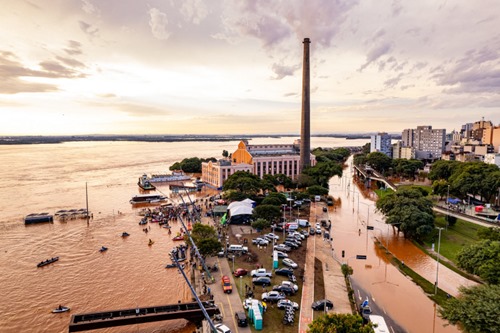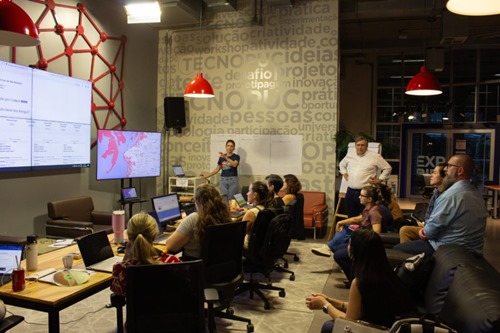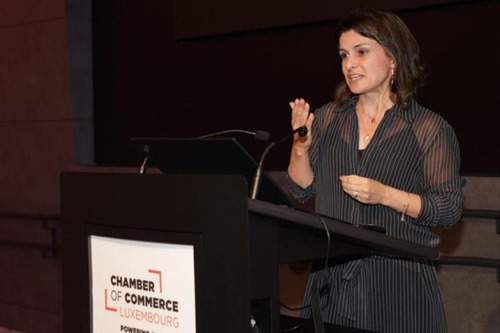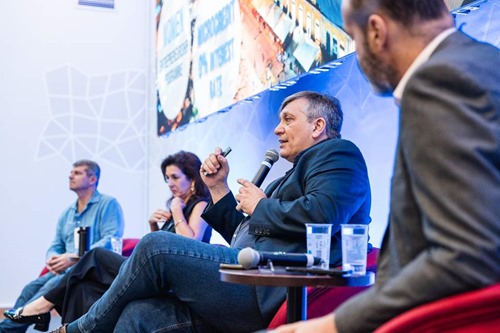Peers around the world: the strength of collaboration in the face of adversity
/WhatsApp_Image_2024-11-26_at_19.33.30_(1).jpg)
This month's peer conversation offers a longer feature interview with two members based within the same city, Porto Alegre, Brazil : Flavia Fiorin – Director of Tecnopuc Science and Technology Park of PUCRS, and Luiz Carlos Pinto da Silva Filho - Universidade Federal do Rio Grande do Sul (UFRGS) / Secretário de Inovação da Cidade de Porto Alegre / Coordenador Equipe diretiva do Pacto Alegre Quarto Distrito.
Both are part of ‘Pacto Alegre’, launched with the participation of local government, universities, private companies, and community organizations. A collaborative initiative in Porto Alegre aimed at fostering urban development through innovation, entrepreneurship and education, Pacto Alegre’s mission is to transform Porto Alegre into a model “smart city” that emphasizes social inclusion, sustainability, and civic engagement. Also present in the region is the Alliance for Innovation, a joint venture of the three universities UFRGS, PUCRS e UNISINOS in order to boost high-impact actions in advancing the innovation ecosystem, aiming to become an international benchmark for innovation, knowledge and entrepreneurship.
This collaborative interview is representative of the great strength and collaboration shown between community, innovation, and government entities which was especially key following the devastating floods in Rio Grande do Sul in April 2024.
Luiz Carlos, as coordinator of the Pacto Alegre, what were some of the first actions implemented once the catastrophic floods that hit Porto Alegre and surrounding regions had subsided?
One of the first things we did, as the Mayor put us in charge of the shelters, was to mobilize the local innovation ecosystem to find quick and agile solutions. This was crucial as the network of shelters grew immensely within a few days to over 160 locations, including clubs, sports facilities, churches, traditional gaucho culture centres, universities, and more. These spaces were adapted to accommodate up to 15,000 people - an unprecedented number in the history of Porto Alegre.
The contribution of the innovation ecosystem was invaluable. In the first days of managing the shelter network, I reached out to innovation businesses in the city, requesting a platform to manage the physical infrastructure of the shelters and track the number of people being sheltered. This call led to two alliances of designers and computer technicians, who, through voluntary efforts, developed two essential management tools: one for tracking the shelters and another for monitoring the people in them.
Beyond this, we needed to provide power, public safety, and physical infrastructure to support the shelters. We then launched a call for solutions, and Tecnopuc quickly became a focal point for authorities and the innovation ecosystem. As one of the few dry locations, it became a meeting place for agile decision-making on how to leverage the city's resources to address the emergency.
Startups also played a vital role. One of them, part of the Living Lab POA initiative, provided reliable data on water levels during the floods using an innovative solution based on cellular signals to calculate sound rebound over water bodies. While other sensors were lost to the force of the waters, this startup's data became our most reliable source for monitoring the evolving water levels of the Guaíba River. Their information helped us calibrate new sensors and refine reference points for flood levels during the event, which was critical for managing the crisis.
Other startups offered advanced technologies, such as computational vision and artificial intelligence, to map water levels, waste piles, and road damage, including pavement deterioration. As the water receded, one startup provided these services for free, helping us identify priority areas for city recovery efforts.
The ecosystem also supported mental health needs. Startups enabled telemedicine and telehealth appointments for people in shelters, addressing paediatric concerns and mental health issues, one of the most pressing demands during the crisis. Hundreds of calls were made to assist those feeling anguish or distress in the shelters.
Additional startups helped connect shelter residents with job opportunities from companies willing to assist during the emergency. Some even travelled from outside Brazil to provide quick water treatment solutions for areas where water plants were offline, ensuring that, if not drinkable, at least usable water was available for cleaning and recovery efforts.
Global tech companies, such as Microsoft, offered software and services free of charge during the emergency. Volunteers from the innovation ecosystem took leadership roles in coordinating rescue efforts, establishing collaborative kitchens to feed thousands, and organizing logistics to support shelters.
During the first week to ten days - before public contracts were fully operational - the voluntary efforts of many individuals, particularly those from the innovation ecosystem, were critical. Innovation spaces like Tecnopuc and Tecnosinos also offered shelter to public administration and businesses affected by the floods, providing free space for operations. If these innovation hubs were connectors before the floods, they became even greater connectors during the crisis, playing a vital role in helping us manage the city during this challenging time.
Flavia, after the flooding, your university PUCRS (Pontifical Catholic University of Rio Grande do Sul) and Science and Technology Park Tecnopuc responded actively to support both its community and the broader Porto Alegre region. How did this affect or change the day-to-day actions and programmes?
PUCRS responded decisively and on multiple fronts to address the challenges brought by the flooding. A temporary shelter was set up on campus, which, for over a month, provided comprehensive support to affected families, including food, accommodation, psychological and health assistance, and legal aid.
At the same time, hundreds of technology volunteers from Porto Alegre’s innovation ecosystem were mobilized to develop solutions to address the emerging challenges caused by the flooding. These volunteers formed various groups, each tackling specific issues related to disaster response, such as logistics to guarantee supplies to the shelter, water distribution, finding and gathering people who were separated during rescues. The volunteers found in Tecnopuc the needed infrastructure and a network of professionals eager to engage and address the urgent needs of the moment.
One of the groups, called Abrigos RS, brought together more than 250 volunteer professionals from different areas - including people from other states in Brazil - who were responsible for registering and directing around 14,000 people to 308 shelters installed in seven cities in Rio Grande do Sul. After a month of work, this application was transferred to the public authorities, which continued the work.
Another group of volunteers focused on logistic challenges identified an opportunity to establish an initiative that continued supporting recovery efforts. This group become a non-profit organization called Bonanza, which has since been consolidated and continues to operate from Tecnopuc. Bonanza is not only focused on aiding Porto Alegre's recovery but has also structured itself to offer solutions to other regions facing similar crises. The organization is now prepared to respond to future emergencies, leveraging the knowledge and networks built during the floods in Porto Alegre.
Besides the volunteers' movement, during the floods, Tecnopuc was committed to host players affected from the Gaucho Innovation Ecosystem. Dozens of technology companies, especially those originally established in the 4th district area, which were heavily affected by the floods, had their headquarters temporarily set up at Tecnopuc in order to ensure their operations were maintained during the crisis and recovery period.
Not only technology startups, but also consolidated companies based in the 4th district or other affected areas, were immediately welcomed into the park to ensure that logistical and health operations, which are critical to the care of the local population, were not paralyzed.
In addition to companies, Tecnopuc was the temporary headquarters of four state and municipal secretariats, as well as the municipality's crisis committee, which were also affected by the advancing waters.
During the most critical period, more than 500 people from dozens of non-resident organizations had temporary workplaces in Tecnopuc to maintain their operations and support those who were forced to stop their activities, including private and public organizations, and state and city government departments.
PUCRS also played a pivotal role in long-term strategies. As part of the Pacto Alegre, the university supported the "Extraordinary Challenge" initiative, rallying ecosystem partners to co-create resilient reconstruction projects. Moreover, PUCRS actively contributes to the State of Rio Grande do Sul’s Scientific Committee, as one of its permanent members. This committee was established to leverage academic expertise in supporting the reconstruction of the state following the floods, focusing on scientific research, innovation, and interdisciplinary solutions. The involvement highlights the role of Tecnopuc as a hub for applied research and collaboration, working alongside other academic institutions and public bodies to develop strategies that address infrastructure resilience, climate adaptation, and disaster prevention. Through this engagement, the Committee provides technical expertise and foster a culture of evidence-based decision-making, ensuring that public policies are grounded in the latest scientific advancements.
This collaborative alliance of initiatives built during the most critical moments continue to shape actions at Tecnopuc, reinforcing its commitment to social innovation, sustainability, and resilience. Looking back at the past few months, today what we see is a city marked by water, still with many challenges to face, but also marked by the strength of people’s resilience, in an ecosystem even more articulated and committed to growing based on collaboration.
Luiz Carlos, did you expect your background in Civil Engineering and work in the analysis of structural integrity, disaster risk reduction, and climate resilience to come into play so close to home? How has your research contributed to the recent projects improving infrastructure resilience in this reconstruction phase?
I have a degree in civil engineering and, throughout my career, I have worked extensively on emergency cases, including façade failures, silo collapses, and dam failures. This experience gave me a strong foundation for dealing with emergencies and understanding the impacts of large natural hazards on civil structures. It was also the reason I was chosen to establish and become the first director of CEPED, one of the oldest university centres for disaster studies and management in Brazil. In 2011, at the Federal University of Rio Grande do Sul (UFRGS), I founded this centre to focus on disasters, risk management, and prevention.
At CEPED, I started analysing data to identify patterns and worked on creating multidisciplinary teams with experts from meteorology, geology, social sciences, anthropology, and digital technologies. Together, we mapped disaster effects across territories and addressed some of the most pressing problems in the state. Our team conducted the first comprehensive survey of emergency calls and protocols across Rio Grande do Sul, uncovering significant patterns. For example, some regions faced both floods and droughts within the same year, emphasizing the urgent need for improved water management.
We also identified how meteorological events in the state were becoming increasingly extreme, with heavier and more concentrated rainfall. These climatic changes, combined with shifts in urban policies and urbanization, accelerated water flow into key basins. One of the most critical basins in Rio Grande do Sul funnels nearly one-third of the state’s rainfall into Porto Alegre within 48 hours. This geographic reality creates contrasting problems: in the highlands, powerful water currents erode land and destroy homes, while in Porto Alegre and its metropolitan area, slow-moving floods occur when water cannot drain into Lagoa dos Patos, compounded by winds from the south that push water levels even higher.
During the recent floods, water levels in Porto Alegre reached unprecedented heights, breaching barriers and flooding 30% of the city. I never expected my expertise as a civil engineer specializing in risk and disaster management to be applied under such extreme circumstances, but I am grateful that my experience helped us manage the crisis effectively.
My background includes organizing some of the first training programs for civil defence teams and firefighters in areas such as rescuing people from collapsed buildings and handling hazardous material spills. My team also contributed to emergency planning during the World Cup in Porto Alegre. These experiences provided valuable insights into command chains and how to operate effectively during crises. This preparation underscores the importance of knowledge, training, and collaboration for public officials and specialists who may be called upon in emergencies.
Flavia, could you tell us more about the "Cidade Educadora" project, and positioning Porto Alegre a leader in integrated, city-wide educational efforts.
The "Cidade Educadora" project reflects Porto Alegre’s commitment to making education a central axis of sustainable development and social inclusion. As part of the International Network of Educating Cities, Porto Alegre fosters a holistic approach to education that integrates formal and informal learning opportunities across urban spaces.
PUCRS, alongside Pacto Alegre and other institutions, plays a vital role in this transformation. For instance, the "4th Cycle of Educating City Projects" mobilized over 100 participants from diverse sectors to develop initiatives linking education, technology, and sustainability. Events such as the Educating City Congress, hosted at Tecnopuc, gathered experts and leaders to share impactful practices, further consolidating Porto Alegre’s status as a global reference.
Key actions include leveraging technology to foster learning and inclusion. PUCRS, through Tecnopuc, offers spaces and projects that promote digital tools to empower communities and encourage active citizenship. The university has also collaborated with the Porto Alegre City Hall to strengthen the city's educational infrastructure, exemplified by the unanimous approval of Porto Alegre’s membership in the International Network of Educating Cities.
This initiative positions Porto Alegre as a leader in integrated urban efforts, showcasing how continuous learning can drive human development and urban renewal.
Part of Porto Alegre’s broader urban renewal goals is of course 4th District, a historically industrial area that has recently transformed into a vibrant centre for culture, innovation, and economic revitalization. Luiz Carlos, what urban planning insights can you share for anyone with their own innovation city-based project?
The 4th District is the District of Innovation, and we have been strongly committed to its development. As a member of IASP and its Innovation Districts Alliance, it has undergone significant transformation, becoming a hub for data centres, new businesses, and cultural activities. Special tax policies have supported creative economy enterprises, technology-driven businesses, and innovation initiatives to establish themselves in the 4th District. However, the recent floods negatively impacted this progress, prompting us to review our commitments to the district, both from the public and private sectors.
One of the most affected areas was Instituto Caldeira, a private innovation hub and fellow IASP member that has grown exponentially to become one of the most important hubs in Brazil, Latin America, and globally, alongside Tecnopuc and Tecnosinos in Rio Grande do Sul and Porto Alegre. During the floods, Caldeira was severely impacted, with water levels exceeding 1.8 meters. Yet, it has shown remarkable resilience. People are returning, and events like Caldeira Week have demonstrated the district’s energy, resilience, and commitment to rebuilding and reshaping the city.
One of the key challenges exposed by the floods was the outdated flood protection system. Pump equipment from the 1970s lacked the capacity to function underwater, and some dams were overtopped due to insufficient height to handle such extreme events. We are now redesigning and updating the entire flood protection system, which will likely take five years to complete.
To support businesses in the 4th District, we have implemented special programs providing financial aid, mentoring, and psychological support to small, medium, and individual enterprises. These measures aim to help businesses survive, recover, and navigate the infrastructure challenges and financial hardships caused by the floods, particularly during the critical first months.
Looking ahead, we are planning a range of new urban renewal projects. These will follow regenerative design principles and focus on resilience and nature-based solutions. In collaboration with ICLEI and SEBRAE, we have issued calls for innovative and sustainable solutions to reimagine the 4th District. Ideas under consideration include creating a flood museum and a living lab to demonstrate how cities can harmonize with nature and water, offering an example for other urban areas facing similar challenges.
The broader river basin, which impacts over 100 municipalities, remains a major focus. However, we want Porto Alegre to serve as a model for how cities can better coexist with water and energy systems. With commitments like the Race to Zero initiative, the city is reaffirming its path toward more sustainable and inclusive innovation.
A critical component of this effort is strong community involvement. Building resilience requires a collaborative approach between public administration and citizens. Many projects are centred on educating people about resilience, disaster management, and risk reduction. In areas like the islands, where traditional flood protection is economically unfeasible, adaptive measures—such as two-story homes with elevated living spaces—are being explored to mitigate damage from frequent smaller floods and prepare for future extreme events. Through these efforts, Porto Alegre aims to minimize losses, protect lives, and emerge as a resilient and innovative city prepared for the challenges of the future.
Flavia, it must be difficult to coordinate the joint action of the various players in the ecosystem. For anyone looking to create an initiative such as Pacto Alegre, what for you have been the main success factors which have led to its sustainability?
The Pacto Alegre exemplifies the transformative potential of collaboration, sustained by several key factors that ensure its long-term success. A base of mutual trust among the triple helix stakeholders - government, universities, companies, and civil society - has been pivotal, fostering alignment of expectations and the establishment of a shared vision for the city’s future and its strategy to achieve it.
This trust has been complemented by a clear sense of purpose and the ability to translate broad ambitions into concrete, measurable actions. Notable achievements, such as the revitalization of the 4th District and Porto Alegre’s membership in the International Network of Educating Cities, demonstrate the alignment between vision and execution.
The initiative’s governance model encourages active participation through regular meetings and co-creation forums, allowing for agile decision-making and adaptability to evolving urban and economic contexts. A hallmark of the Pacto Alegre has been its capacity to mobilize diverse sectors of society, channelling collective intelligence into innovative solutions. The “Extraordinary Challenge,” for instance, showcased how this collaborative spirit can yield effective responses to crises.
Equally significant is the strategic communication of progress and the celebration of milestones, which have played a crucial role in maintaining stakeholder engagement and motivation. Over the past five years, these practices have reinforced the initiative's reputation as a transformative force in urban innovation.
This combination of trust, clarity of purpose, inclusive governance, community engagement, and effective communication ensured the Pacto Alegre’s success and established it as a global benchmark for urban innovation development models. From our experience in Porto Alegre, for those seeking to establish a pact for innovation, we highly recommend to address the local challenges based on sustained collaboration models, with a long-term vision, and flexibility to adapt when facing any important event that impacts the local reality.
.jpg)











/)

/canvascolor(0xffffffff)/2017_10_30_Singapore_Singapore_SP.jpg.png)
/canvascolor(0xffffffff)/2017_11_13_UK_NETPark.jpg)
/canvascolor(0xffffffff)/PSP_Logo-mit-Schriftzug_1.jpg)
/canvascolor(0xffffffff)/Untitled_11.jpg)
/canvascolor(0xffffffff)/Svart_kontur_liggande_ssclogo_1.png)
/canvascolor(0xffffffff)/Andorra_RGB_RI-1_1.png)
/canvascolor(0xffffffff)/MemberLogo-75401-5958.jpg)
/canvascolor(0xffffffff)/2022_05_09_Czech_Republic_Technology_Park_Brno_1.png)
/canvascolor(0xffffffff)/2017_10_31_Spain_Fundacion_Comunitat_Valencian.jpg)
/canvascolor(0xffffffff)/MemberLogo-5826-6312.jpg)
/canvascolor(0xffffffff)/WhatsApp_Image_2023-08-01_at_14.01.59_5.jpg)
/canvascolor(0xffffffff)/Connect_MPID_Tagline_RGB_Lockup.png)
/canvascolor(0xffffffff)/MemberLogo-5669-6104.jpg)
/canvascolor(0xffffffff)/2018_03_30_Canada_Technoparc_Montreal.png)
/canvascolor(0xffffffff)/SLSP_logo_2022.png)
/canvascolor(0xffffffff)/2017_07_31_PITA.jpg)
/canvascolor(0xffffffff)/MemberLogo-5640-6065.jpg)
/canvascolor(0xffffffff)/FOTO-PERFIL-2.png)
/canvascolor(0xffffffff)/Landvetter_sodra_logo.jpg)
/canvascolor(0xffffffff)/2022_01_26_Spain_PCT_Tenerife.jpg)
/canvascolor(0xffffffff)/MemberLogo-5769-6232.jpg)
/canvascolor(0xffffffff)/MemberLogo-68701-6096.jpg)
/canvascolor(0xffffffff)/2017_08_07_HHTP.png)
/canvascolor(0xffffffff)/MemberLogo-5740-6195.jpg)
/canvascolor(0xffffffff)/V_1.jpg)
